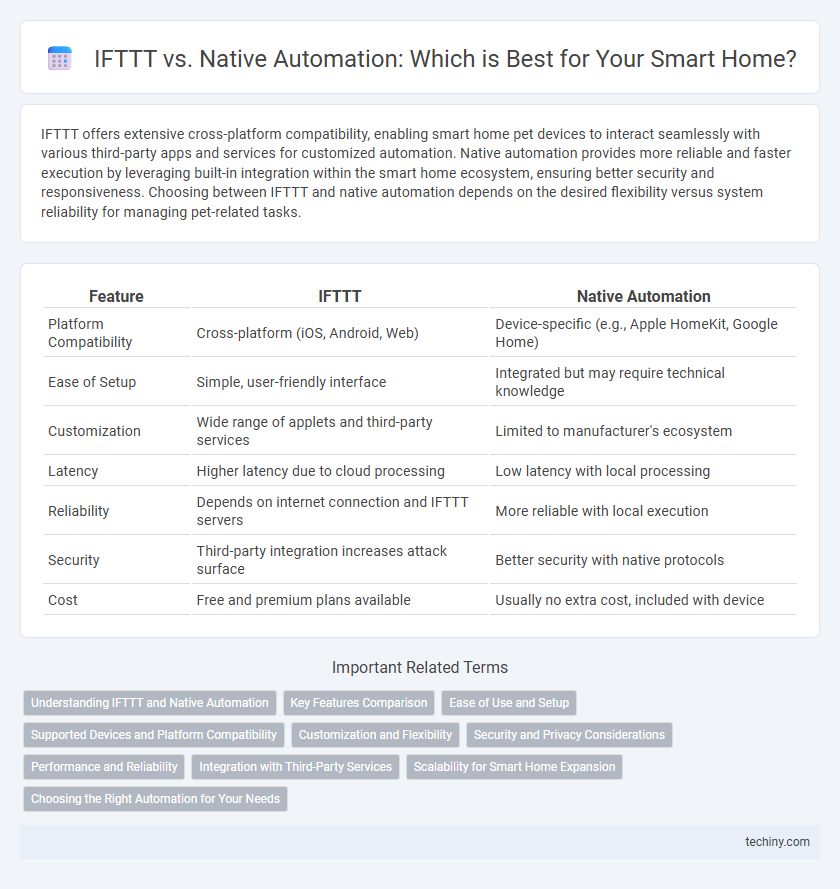IFTTT offers extensive cross-platform compatibility, enabling smart home pet devices to interact seamlessly with various third-party apps and services for customized automation. Native automation provides more reliable and faster execution by leveraging built-in integration within the smart home ecosystem, ensuring better security and responsiveness. Choosing between IFTTT and native automation depends on the desired flexibility versus system reliability for managing pet-related tasks.
Table of Comparison
| Feature | IFTTT | Native Automation |
|---|---|---|
| Platform Compatibility | Cross-platform (iOS, Android, Web) | Device-specific (e.g., Apple HomeKit, Google Home) |
| Ease of Setup | Simple, user-friendly interface | Integrated but may require technical knowledge |
| Customization | Wide range of applets and third-party services | Limited to manufacturer's ecosystem |
| Latency | Higher latency due to cloud processing | Low latency with local processing |
| Reliability | Depends on internet connection and IFTTT servers | More reliable with local execution |
| Security | Third-party integration increases attack surface | Better security with native protocols |
| Cost | Free and premium plans available | Usually no extra cost, included with device |
Understanding IFTTT and Native Automation
IFTTT (If This Then That) enables smart home devices to interact through customizable applets, offering broad compatibility across brands and services. Native automation relies on built-in features within a specific smart home ecosystem, providing faster and more reliable device control with deeper integration. Choosing between IFTTT and native automation depends on the desired flexibility versus performance and ecosystem cohesion in smart home management.
Key Features Comparison
IFTTT offers extensive cross-platform integration, enabling automation between diverse smart home devices and services through customizable applets that support a wide range of triggers and actions. Native automation, built into specific ecosystems like Apple HomeKit or Google Home, provides deeper device-level control, faster execution, and enhanced security by leveraging proprietary protocols and local processing. Key features comparison highlights IFTTT's flexibility and third-party compatibility versus native automation's reliability, reduced latency, and seamless integration within a single smart home environment.
Ease of Use and Setup
Native automation in smart homes offers seamless integration with specific devices, providing streamlined setup and user-friendly interfaces tailored to the ecosystem. IFTTT supports a broader range of brands and services, enabling cross-platform automation but often requires more complex configuration and multiple accounts. Users prioritizing simplicity and quick deployment typically prefer native automation, while those seeking extensive customization might lean towards IFTTT.
Supported Devices and Platform Compatibility
IFTTT offers extensive support for a wide range of smart home devices across multiple brands, making it highly versatile for users with diverse ecosystems. Native automation solutions are typically optimized for specific platforms like Apple HomeKit, Google Home, or Amazon Alexa, providing deeper integration and more reliable performance within their respective ecosystems. Platform compatibility in native automation ensures seamless device interaction but limits cross-brand device interoperability compared to IFTTT's broader reach.
Customization and Flexibility
Native automation offers deeper integration and more precise control over smart home devices through platform-specific features, enabling highly customized routines. IFTTT provides broad compatibility across diverse brands and services, allowing users to link otherwise incompatible devices for flexible automation. While native solutions excel in responsiveness and security, IFTTT enhances customization by bridging multiple ecosystems and expanding automation possibilities beyond native capabilities.
Security and Privacy Considerations
IFTTT relies on cloud-based servers, increasing exposure to potential data breaches and unauthorized access, while native automation processes data locally, enhancing device security and minimizing privacy risks. Native automation supports encrypted data transmission directly between devices without third-party intermediaries, reducing vulnerabilities often present in IFTTT integrations. Prioritizing native automation ensures better control over sensitive information and compliance with stringent privacy standards in smart home environments.
Performance and Reliability
Native automation offers superior performance and reliability in smart home systems by executing commands directly on the device or local hub, minimizing latency and reducing dependence on internet connectivity. IFTTT relies on cloud-based services to trigger actions across different platforms, which can introduce delays and potential points of failure due to network issues or server downtime. Users seeking fast, consistent responses and robust operation typically prefer native automation for critical smart home functions.
Integration with Third-Party Services
IFTTT offers extensive integration with thousands of third-party services, enabling seamless automation across a wide range of smart home devices and platforms. Native automation systems typically provide more reliable and faster execution but are limited to the ecosystem's proprietary devices and supported services. Choosing between IFTTT and native automation depends on the need for broad compatibility versus optimized performance within a specific smart home environment.
Scalability for Smart Home Expansion
IFTTT offers broad device compatibility, enabling scalable smart home setups by connecting disparate brands and services through cloud-based applets. Native automation provides deeper integration with specific ecosystems, allowing for more reliable, responsive control but limited to the manufacturer's devices and protocols. For expansive smart home systems, IFTTT's scalability outperforms native automation by supporting a wider range of devices and cross-platform triggers essential for comprehensive automation growth.
Choosing the Right Automation for Your Needs
Selecting the right automation method depends on your smart home ecosystem and desired functionality. IFTTT offers broad compatibility and customizable applets for diverse device integration, while native automation provides faster response times and deeper device-specific features within a single platform. Evaluating device compatibility, ease of setup, and reliability ensures optimal performance tailored to your home automation needs.
IFTTT vs Native Automation Infographic

 techiny.com
techiny.com